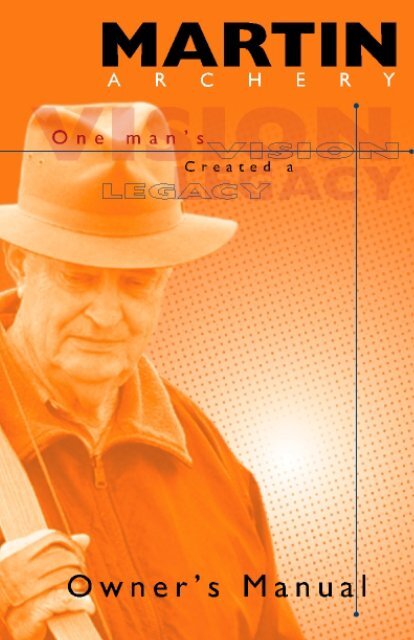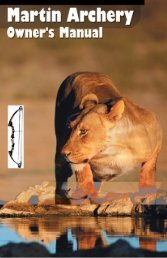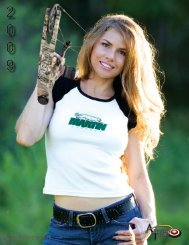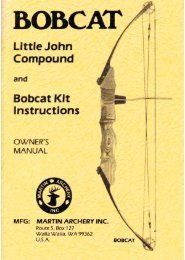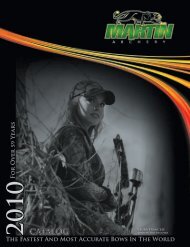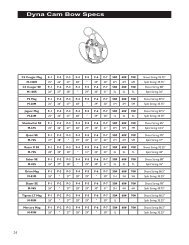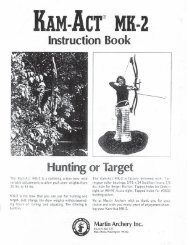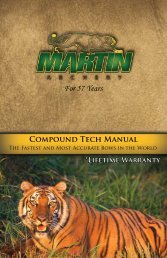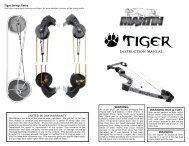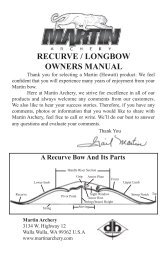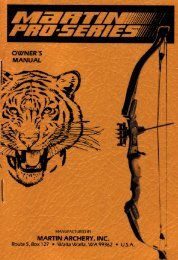fine tuning your compound bow - Martin Archery
fine tuning your compound bow - Martin Archery
fine tuning your compound bow - Martin Archery
You also want an ePaper? Increase the reach of your titles
YUMPU automatically turns print PDFs into web optimized ePapers that Google loves.
Welcome to the <strong>Martin</strong> <strong>Archery</strong> Family. We are confident that<br />
you will experience many years of enjoyment from <strong>your</strong> new <strong>Martin</strong><br />
<strong>bow</strong>. Each <strong>bow</strong> that leaves our door is handmade one at a time as they<br />
have been for fifty years. <strong>Martin</strong> <strong>Archery</strong> remains a family owned and<br />
operated business. We take great pride in every product we produce and<br />
we strive to offer you the most complete line of professional accessories<br />
available.<br />
We welcome any comments you may have about our products.<br />
We also like to hear stories of <strong>your</strong> successes while using our products. If<br />
you have any comments, photos, or information you would like to share<br />
with us, please call or write. We will do our best to answer any questions<br />
you may have.<br />
To better serve you, we have the most complete archery manufacturers<br />
Web page on the World Wide Web. Our home page includes a<br />
hot link directly to our E-Mail box so you can keep in touch with us.<br />
Our Web page is located at: www.martinarchery.com<br />
Our E-Mail address is: info@martinarchery.com<br />
Thank You,<br />
2<br />
Gail <strong>Martin</strong><br />
Founder and President<br />
<strong>Martin</strong> <strong>Archery</strong> Inc.
TABLE OF CONTENTS<br />
OWNERS RECORD ......................................................................................... 4<br />
PARTS OF THE BOW..................................................................................... 5<br />
BASIC SETUP<br />
• Cable Guard Installation ..................................................... 6<br />
• Setting Draw Length ........................................................... 6<br />
• Changing Draw Weight ....................................................... 7<br />
• Setting Tiller ........................................................................ 7<br />
• Wheel Timing (For Two Cam Systems) ............................... 8<br />
• Setting Arrow Rest Position................................................. 9<br />
• Setting Nock Point ............................................................... 9<br />
• Replacing Strings ................................................................ 9<br />
• Care and Storage................................................................. 9<br />
THE FURY CAM & FURY X<br />
• Getting Peak Performance ................................................... 12<br />
• Cam Positioning .................................................................. 12<br />
THE FUZION SINGLE CAM SYSTEM <br />
• Adjusting Draw Length ....................................................... 10<br />
• Setting Tiller ........................................................................ 11<br />
• String Configuration ........................................................... 11<br />
THE Z CAM<br />
• Setting Draw Length ........................................................... 6<br />
• Changing draw weight ........................................................ 7<br />
• Setting Tiller ........................................................................ 7<br />
FINE TUNING YOUR COMPOUND BOW<br />
• Bare Shaft Planing Test ....................................................... 13-14<br />
• Paper Tuning ....................................................................... 15-17<br />
SUPER FINE TUNING<br />
• Short Range Group Tuning ................................................. 18<br />
• Flight Tuning Broadheads ................................................... 19<br />
TEN COMMANDMENTS OF ARCHERY SAFETY ........................ 20<br />
FREQUENTLY ASKED QUESTIONS.................................................... 21<br />
MARTIN WARRANTY................................................................................... 22<br />
3
OWNER'S RECORD<br />
BOW MODEL: ________________________________<br />
LIMB TYPE: ________________________________<br />
CAM: ________________________________<br />
DRAW WEIGHT: ________________________________<br />
DRAW LENGTH: ________________________________<br />
STRING LENGTH: ________________________________<br />
PURCHASED FROM: ________________________________<br />
DATE: ________________________________<br />
NOTICE:<br />
Staple <strong>your</strong> sales receipt here<br />
Proof of purchase date is needed<br />
should you ever require warranty work<br />
4
PARTS OF THE BOW<br />
Idler Wheel<br />
Axle<br />
Split String<br />
Upper Limb<br />
Limb Bolt<br />
Riser<br />
Slide Slot Rest<br />
Mounting Hole<br />
Grip<br />
Shooting String<br />
Barrel Nut<br />
Quiver Mounts<br />
Cable Guard<br />
Lock Mount<br />
Rest Mounting<br />
System<br />
Stabilizer Insert<br />
Limb Pocket<br />
Lower Limb<br />
Fuzion Cam<br />
(Cougar with Fuzion Cam System)<br />
5
BASIC SETUP<br />
Your new <strong>Martin</strong> <strong>bow</strong> takes little setup to get started shooting. Please read<br />
and familiarize <strong>your</strong>self with these starting procedures before shooting. Many<br />
of these procedures will have been completed by <strong>your</strong> authorized <strong>Martin</strong> dealer.<br />
After completing these simple steps, you will be more accurate and will have<br />
greater success from the start. A careful and thorough initial setup will make<br />
the <strong>tuning</strong> process much easier.<br />
CABLE GUARD INSTALLATION<br />
All <strong>Martin</strong> <strong>compound</strong> <strong>bow</strong> models* feature smooth<br />
bore holes in the riser that allow direct, bracket-free<br />
installation of the cable guard rod. There are set screws<br />
within the riser that will secure the rod.<br />
The cable guard rod should be rotated toward the grip to<br />
provide adequate fletching clearance. Caution should be<br />
taken against over-rotating the rod as excessive clearance<br />
can cause unnecessary pressures on the limb tips and axle<br />
bushings. Only 9/16” offset is necessary to provide<br />
adequate fletching clearance.<br />
Though most <strong>bow</strong> models allow either an upper (above<br />
the arrow rest) or lower (below the grip) mounting, <strong>Martin</strong><br />
<strong>Archery</strong> recommends the upper mounting position on all<br />
Fuzion single cam models.<br />
*As of this writing, the Scepter II and Rage models did<br />
not allow the direct installation of a cable guard rod. A<br />
mounting bracket is supplied with these models that threads<br />
into the threaded holes provided in the back of the riser.<br />
SETTING DRAW LENGTH<br />
Z Cams and Mini Z Cams<br />
The Z Cam uses draw length modules to adjust the<br />
draw length. The size of each module is designated by a<br />
number followed by an 'X'. These modules are sized from<br />
2X to 9X. The 9X makes the longest draw and the length<br />
decreases one inch for each number. To change the draw<br />
length on these cams, simply remove the two screws<br />
holding the module to the cam. Take a look at the module<br />
number and select a new module that will give you the<br />
correct draw length. Install the new modules, making sure<br />
that the numbers on each module match.<br />
NOTE: Do not draw <strong>your</strong> <strong>bow</strong> without the modules installed.<br />
It will cause damage to <strong>your</strong> harness system.<br />
Cable<br />
Guard<br />
6
Fury Cams & Fury X<br />
The Fury Cam is a draw length specific cam. Each cam was designed to give peak<br />
performance and speed at each specific draw length. Therefore, changing the draw<br />
length requires changing to a different size cam.<br />
Fuzion Single Cam System<br />
A full explanation on the Fuzion Cam System, including changing the draw length,<br />
can be found on page 10 and 11.<br />
CHANGING DRAW WEIGHT<br />
<strong>Martin</strong> <strong>bow</strong>s have a fifteen pound draw weight range. Using the 3/16” Allen wrench<br />
supplied with each <strong>bow</strong>, you will turn the limb bolts clockwise to add weight and turn<br />
counter clockwise to reduce weight. One complete turn on each limb bolt provides<br />
about 4 pounds of adjustment.<br />
TIP: Mark a line on each limb bolt in white-out or white paint marker to make it easier<br />
to keep track of how far you are turning each bolt.<br />
NOTE: Do not shoot <strong>your</strong> <strong>bow</strong> with the limb bolts more than 5 turns out from the riser.<br />
SETTING TILLER<br />
After setting the draw weight on <strong>your</strong> <strong>bow</strong>, you will need<br />
to set the tiller measurement to make sure that you have<br />
adjusted <strong>your</strong> limbs properly. On all <strong>Martin</strong> <strong>compound</strong> <strong>bow</strong>s,<br />
“0” tiller will shoot perfectly. However, the tiller<br />
measurement can vary up to 1/4” closer at the bottom.<br />
There is no set measurement that provides peak performance<br />
for every shooter. To measure <strong>your</strong> tiller, simply<br />
measure from the limb pockets to the string on both ends<br />
of the <strong>bow</strong> (see Fig.1). You can custom fit the feel of <strong>your</strong><br />
<strong>bow</strong> by experimenting with the tiller setting. Start with<br />
even tiller, when both top and bottom limbs are adjusted<br />
the same. (Before adjusting <strong>your</strong> limb bolts, mark a white<br />
line from the center of the limb bolt to the outside. This<br />
will help you keep track of <strong>your</strong> settings.) By tightening<br />
one bolt a quarter turn at a time you will begin to affect<br />
the steadiness of <strong>your</strong> setup. If the <strong>bow</strong> begins to become<br />
unsteady, move the tiller back to even and tighten the opposite<br />
limb bolt. After finding the best spot, make a note so<br />
if you ever change the draw weight you can reset the tune<br />
where you had it shooting best (i.e., 3/4 bottom would<br />
mean three quarters of a turn on the bottom limb bolt).<br />
NOTE: Your peep sight position and <strong>your</strong> nock point will<br />
change as you turn one limb bolt. Take measurements and<br />
correct <strong>your</strong> nock and peep each time you turn <strong>your</strong> bolts.<br />
7<br />
Fig.1
WHEEL TIMING (FOR TWO CAM SYSTEMS)<br />
It is important for consistency and accuracy that <strong>your</strong> <strong>bow</strong>’s cams “roll over” at the<br />
same instant and are in the same position when you are at full draw. Your cams<br />
should be synchronized or “timed” to <strong>your</strong> particular style of shooting. To check the<br />
timing, draw <strong>your</strong> <strong>bow</strong> with <strong>your</strong> fingers or release just as you would while shooting.<br />
Different drawing methods will affect the roll over of <strong>your</strong> cams. Draw the <strong>bow</strong> using<br />
<strong>your</strong> exact shooting method.<br />
Cams are in<br />
perfect time.<br />
Upper Cam is<br />
over-rotated and<br />
out of sync with<br />
the bottom cam<br />
Adjust this yoke<br />
by twisting up the<br />
bottom Split<br />
String cable.<br />
Adjusting timing using the Split String System (synthetic cables)<br />
This procedure can be expertly performed by <strong>your</strong><br />
String Anchor<br />
local archery professional. You will need a <strong>bow</strong> press<br />
or a <strong>bow</strong> stringer to adjust <strong>your</strong> timing using the Split<br />
String System. First, determine which cam is ahead,<br />
or out of sync. The Split Strings, or buss cables, should<br />
Split<br />
reach the end of the cable grooves on the Power Side<br />
String<br />
(back side) of each cam at the same time. Then, while<br />
the <strong>bow</strong> is relaxed, remove the appropriate Split String<br />
off its outside posts and twist in a direction that<br />
shortens or tightens the cable. A few turns will go a<br />
long way so proceed sparingly. If <strong>your</strong> top cam is ahead,<br />
or rotates further than <strong>your</strong> bottom cam, twist the<br />
bottom Split String, do the opposite if the bottom wheel<br />
is ahead. After these steps are completed make sure<br />
that all of <strong>your</strong> string loops are firmly secured on their<br />
appropriate pegs before the pressure is reapplied to<br />
the <strong>bow</strong>.<br />
NOTE: Back <strong>your</strong> <strong>bow</strong> limbs out five turns from the riser before using a <strong>bow</strong> stringer or<br />
a <strong>bow</strong> press. Only let a qualified professional put <strong>your</strong> <strong>bow</strong> in a <strong>bow</strong> press.<br />
8
SETTING ARROW REST POSITION<br />
After <strong>your</strong> arrow rest is installed on <strong>your</strong> <strong>bow</strong>, you will need<br />
to set the rest to the best centered location to begin <strong>tuning</strong>. The<br />
easiest way to do this is to visually align the <strong>bow</strong>string in the<br />
center of the grip section. If you are shooting <strong>your</strong> <strong>bow</strong> with a<br />
release aid, the prongs or blade of <strong>your</strong> shoot-through rest will<br />
need to be centered with the <strong>bow</strong> string. During <strong>tuning</strong>, <strong>your</strong><br />
arrow rest may need to be moved in or out from it’s centered<br />
location. This is normal because different shooters apply<br />
different pressures to the <strong>bow</strong>. Finger shooters will need to<br />
position the rest so that the point is about 1/8” outside the string.<br />
This is to compensate for the horizontal bending of the arrow<br />
upon release. An arrow rest that provides some side support,<br />
such as a cushion button, for the arrow is best for finger<br />
shooters.<br />
Bowstring<br />
SETTING NOCK POINT<br />
Place a <strong>bow</strong> square on the string and slide the square down<br />
until it rests on <strong>your</strong> arrow rest. Then place a moveable nock set<br />
on the string. Using the measuring scale on the <strong>bow</strong> square, set<br />
the nock set at the proper location on the string. A good<br />
starting point for finger shooting is 1/4” high, measuring from<br />
the bottom of the nock set to 90° on the <strong>bow</strong> string. Start at ¼”<br />
high if you are using a release aid. If you do not have a <strong>bow</strong><br />
square, you can snap an arrow on the string and visually level<br />
the arrow. Then crimp <strong>your</strong> nock set. In a pinch, this will get<br />
you to a good starting location.<br />
1/2<br />
1/4<br />
90 0<br />
REPLACING THE STRINGS<br />
Should <strong>your</strong> string need replacing, it is best to go to <strong>your</strong> <strong>Martin</strong> dealer and have it<br />
expertly done. It is recommended that you replace <strong>your</strong> string once a year or anytime<br />
it shows wear. Always be sure that the string you replace it with is the correct length<br />
and material for <strong>your</strong> <strong>bow</strong>.<br />
CARE AND STORAGE<br />
When properly cared for, <strong>your</strong> new <strong>Martin</strong> <strong>bow</strong> will give you years of<br />
trouble-free service. When <strong>your</strong> <strong>bow</strong> is new it will require no lubrication. Over time<br />
you may need to lubricate <strong>your</strong> cams to guard against friction and noise. Use a dry<br />
lubrication such as Teflon spray powder or graphite powder. Do not use wet or oily<br />
lubrication. Using a wet type lubrication will attract grit and dust that may cause<br />
premature wear in wheel bushings.<br />
A good rule of thumb when caring for <strong>your</strong> <strong>bow</strong> is to keep it as comfortable as you<br />
are. If it is too hot for you, it is too hot for <strong>your</strong> <strong>bow</strong>. If it gets wet, dry it off completely.<br />
Periodically clean <strong>your</strong> <strong>bow</strong> with a wet rag and mild soap to remove mud or dust<br />
(caution: do not store until completely dry). Prolonged exposure to<br />
extreme heat may cause failure in <strong>your</strong> <strong>bow</strong> limbs and excessive stretch in <strong>your</strong><br />
harness system. It will not hurt <strong>your</strong> <strong>bow</strong> if it is rained on while shooting, but make<br />
sure it is completely dry before storing in a <strong>bow</strong> case to guard against rust or<br />
corrosion.<br />
9
THE FUZION SINGLE CAM SYSTEM<br />
The Fuzion system is unique among all other single cam systems. The Fuzion<br />
system has a modular draw length adjustment that can be adjusted in half inch adjustments<br />
within each draw length module.<br />
ADJUSTING THE DRAW LENGTH<br />
The Fuzion Single Cam System boasts a<br />
revolutionary design and is engineered to give you<br />
peak performance and speed. Using draw length<br />
modules, the draw length can be adjusted in 1"<br />
increments (see fig. 1) The modules can also be used<br />
to adjust the let-off. A high let-off module is marked<br />
as F-#. A 65% let off module is marked with a F-#\.<br />
The slash on the end of the size number indicates<br />
65% let-off. To change the draw length replace the<br />
module on the cam by removing the screws that hold<br />
it to the cam (see Fig.3). NOTE: do not draw <strong>your</strong><br />
<strong>bow</strong> without the module installed. It will damage<br />
<strong>your</strong> harness. The Fuzion module sizes range from<br />
F-1 to F-7. If you would like to increase the draw<br />
length select a higher number. If you would like to<br />
decrease the draw length select a lower number. The Fig.1<br />
draw length can also be adjusted up or down 1/2"<br />
using the pegs on the back of the cam (see fig.1). The #2 peg is the prescribed draw<br />
length for each module. The #1 peg is 1/2" longer and the #3 peg is 1/2" shorter. The<br />
draw weight will change one or two pound, accordingly, when using the peg adjustment.<br />
Fuzion Module<br />
#3054 F1 - F7<br />
Fuzion Cam<br />
#3050<br />
BP-6 module<br />
screws<br />
Fig.3<br />
10
SETTING THE TILLER<br />
Your Fuzion <strong>bow</strong> should start out with an even tiller setting. Even tiller, or "0"<br />
tiller, makes sure both limb bolts are adjusted evenly. (see Fig.2)<br />
Fig.2<br />
STRING CONFIGURATION<br />
The string harness on the new Fuzion are installed according to the diagram below<br />
(see Fig.4). Your string harness should be installed by <strong>your</strong> qualified <strong>Martin</strong> dealer.<br />
Shooting<br />
String<br />
Split<br />
String<br />
Fig.4<br />
11
THE FURY CAM & FURY X<br />
GETTING PEAK PERFORMANCE<br />
The Fury Cam is designed to provide optimum performance when the draw weight<br />
is at its maximum setting. In order to attain the top performance expected from this<br />
Cam system, it is strongly recommended that the draw weight be set at its maximum.<br />
This setting will also keep noise to a minimum and benefit accuracy.<br />
CAM POSITIONING<br />
In order to achieve the ideal draw force curve and resulting maximum efficiency, the<br />
Fury Cams need to be positioned properly. Though the exact cam position is not<br />
critical, the straight section of the cam should be aligned vertically and parallel with<br />
the <strong>bow</strong>string (see diagram). No exact measurement is required, just a visual check<br />
will be sufficient. Should the <strong>bow</strong> string stretch abnormally, the straight section of the<br />
cam can rotate closer to the <strong>bow</strong>string, increasing draw length and draw weight while<br />
adversely affecting performance. Add twists to the <strong>bow</strong>string to reduce its length and<br />
return the cam back to its proper alignment.<br />
Proper<br />
orientation<br />
of string and<br />
Cam point.<br />
Proper cam<br />
positioning as<br />
seen on the<br />
<strong>bow</strong>. This<br />
positioning<br />
applies to any<br />
<strong>bow</strong> using the<br />
Fury Cam.<br />
FURY X STRING CONFIGURATION<br />
Strings: Use same string lengths as the standard Fury Cam system. You will need a<br />
four buss cables and one shooting string. Cables can be made with as few as 8 strands<br />
of BCY 450+ or S-4 material. Shooting strings need the standard strand count.<br />
Large<br />
Existing Cable Anchor<br />
Cable Anchor<br />
White<br />
Spacer<br />
Black<br />
Spacer<br />
12
FINE TUNING YOUR COMPOUND BOW<br />
After completing the basic setup procedures, you are now ready to <strong>fine</strong> tune <strong>your</strong><br />
setup for the best accuracy possible. There are four <strong>tuning</strong> methods described in this<br />
section. Some of these methods may not apply to certain styles of shooting. Read the<br />
introduction to each method carefully to make sure it applies to <strong>your</strong> shooting style.<br />
BARE SHAFT PLANING TEST<br />
The Bare Shaft Planing method of <strong>tuning</strong> works best when using a finger release. To<br />
begin the Bare Shaft Planing test you will need three fletched arrows and one or two<br />
bare shafts. You will also need a target that will catch the arrows without allowing the<br />
arrow to kick as it stops in the target. This test will help you establish the correct nock<br />
and rest position, and it will tell you if <strong>your</strong> arrow is the correct spine. Porpoising and<br />
Fish Tailing describe the different flight disturbances you will encounter while <strong>tuning</strong>.<br />
Porpoising<br />
Porpoising is identified by an up and down kick during arrow flight and relates to<br />
the nock point adjustment. It is important to correct porpoising first because small left<br />
and right disturbances could be nock point related. Start at about ten to fifteen yards<br />
and shoot three fletched arrows into <strong>your</strong> target. Using the same aiming point, follow<br />
them up with a bare shaft. After you get the shafts to impact with the fletched shafts,<br />
you may want to try shooting them at a longer distance for a <strong>fine</strong>r indication of arrow<br />
flight.<br />
A high nock set will cause porpoising<br />
If the bare shafts impact below the fletched arrows, <strong>your</strong> nock point is too high.<br />
Move <strong>your</strong> nocking point down in small increments until the bare shaft strikes with the<br />
fletched shafts. If the bare shafts impact above <strong>your</strong> fletched arrows, <strong>your</strong> nock point is<br />
too low. Lower <strong>your</strong> nock point in small increments until <strong>your</strong> fletched arrows and<br />
<strong>your</strong> bare shaft impact together.<br />
Repeat the above steps from a longer distance to make sure you have completely<br />
corrected the nock point. Shooting from a longer distance will make minor<br />
disturbances more apparent.<br />
Low nocking point<br />
13<br />
High nocking point
Fishtailing<br />
Fishtailing relates to the arrow rest adjustment and the stiffness of <strong>your</strong><br />
arrow. Just as before, start at about ten to fifteen yards and shoot three fletched arrows<br />
into <strong>your</strong> target. Using the same aiming point, follow them up with a bare shaft. After<br />
you get the shafts to impact with the fletched shafts, you may want to try shooting them<br />
at a longer distance for a <strong>fine</strong>r indication of arrow flight.<br />
If <strong>your</strong> unfletched shafts impact to the left of <strong>your</strong> fletched shafts, <strong>your</strong> arrow is too<br />
stiff. There are several things that you can do to correct this problem; you can select a<br />
weaker arrow, you can decrease the cushion plunger tension. Increasing the peak<br />
weight of <strong>your</strong> <strong>bow</strong> or increasing <strong>your</strong> point weight will also make <strong>your</strong> arrow act a<br />
bit more limber. If <strong>your</strong> unfletched shafts impact to the right of <strong>your</strong> fletched shafts,<br />
<strong>your</strong> arrow is too limber. There are several methods you can try that will correct this<br />
problem; you can select a stiffer arrow, you can increase the cushion plunger tension.<br />
Decreasing the peak weight of <strong>your</strong> <strong>bow</strong> or decreasing <strong>your</strong> point weight will also<br />
make <strong>your</strong> arrow act a bit more stiff.<br />
To further <strong>fine</strong> tune <strong>your</strong> setup, step back to twenty or thirty yards and repeat the<br />
above procedures. Small flight disturbances will show up better as you get farther<br />
from the target. Your <strong>Martin</strong> <strong>bow</strong> is essentially tuned when <strong>your</strong> bare shafts hit<br />
together with <strong>your</strong> fletched shafts. Keep in mind that if you continue and complete the<br />
super <strong>fine</strong> <strong>tuning</strong> methods in this manual, it is not uncommon for <strong>your</strong> bare shaft<br />
impact to change. Your <strong>bow</strong> will be shooting its best and it is common for a perfectly<br />
tuned <strong>bow</strong> to shoot a bare shaft a bit low and right or low and left. Perfect arrow<br />
groups are the goal when completing these exercises.<br />
Stiff Arrow- bare<br />
shafts fly to left.<br />
Limber Arrow-bare<br />
shafts fly to right.<br />
Left handed shooters should follow instructions in reverse.<br />
14
PAPER TUNING<br />
Paper <strong>tuning</strong> will work for all styles of shooting. As you are going through these<br />
steps keep in mind that paper <strong>tuning</strong> is not chiseled in stone as the law of archery. It is<br />
a guideline for clean arrow flight. Many shooters find that their setup groups best<br />
when achieving less than perfect <strong>tuning</strong> results. For example, some target shooters set<br />
their <strong>bow</strong>s to tear slightly high through the paper. They feel this makes their arrow<br />
flight less likely to be influenced by outside variables like wind or rain and helps arrow<br />
clearance when using a shoot-around type rest such as a blade or pan type launcher.<br />
To begin paper <strong>tuning</strong>, set up a frame or rack with paper suspended from the frame.<br />
Position the frame far enough away from <strong>your</strong> backstop so the arrow can<br />
completely clear the paper. Stand about ten feet from the paper and make sure <strong>your</strong><br />
arrow is level as it flies through the paper. Fire a test shot and read the results.<br />
Compare the holes you have made in the paper to the diagrams below. Procedures for<br />
correcting the tear are listed next to each diagram. Please note that <strong>tuning</strong><br />
procedures recommended for finger shooting often differ from those used for<br />
release shooting. You will find that the arrow spine reaction is different for fingers and<br />
release, therefore, the procedures for correcting the different disturbances vary.<br />
Follow the instructions carefully for <strong>your</strong> particular shooting style.<br />
HIGH TEAR (fletching tears above point)<br />
This tear may signal:<br />
•Nocking point too high.<br />
Lower the nocking point.<br />
•Improper vane clearance.<br />
See if arrow fletching is hitting the rest.<br />
•Launcher is too stiff (release shooters).<br />
Weaken spring tension or use a more limber launcher.<br />
•Wheels may be out of time.<br />
Check wheel timing.<br />
•Arrow may be too limber<br />
Select a stiffer arrow shaft.<br />
•Tiller adjustment may be incorrect.<br />
See basic setup section page 7.<br />
•Irregular or inconsistent shooting form.<br />
See a qualified archery coach or professional and have them check <strong>your</strong> technique.<br />
LOW TEAR (fletching tears below point)<br />
This tear may signal:<br />
•Nocking point too low.<br />
Raise the nocking point.<br />
•Wheels may be out of time.<br />
Check wheel timing.<br />
•Tiller adjustment may be incorrect.<br />
See basic setup section on page 7.<br />
•Irregular or inconsistent shooting form.<br />
See a qualified archery coach or professional and have them check <strong>your</strong> technique.<br />
15
RIGHT TEAR (fletching tears to the right of point)<br />
This tear may signal:<br />
Note: If you are left handed follow these instructions in reverse.<br />
FINGERS:<br />
•Stiff arrow.<br />
This problem is cured using the following methods:<br />
a. Increase peak weight.<br />
b. Use a heavier point.<br />
c. Select a more limber arrow.<br />
d. Lighten cushion plunger tension, or use a weaker spring on shoot around rests.<br />
e. Make small incremental rest adjustments towards the <strong>bow</strong>.<br />
RELEASE:<br />
•Arrow rest is too far to the right.<br />
Move arrow rest to the left.<br />
EITHER STYLE:<br />
•Too much pressure on the cable guard.<br />
Rotate cable guard for minimum fletching clearance.<br />
•Irregular or inconsistent shooting form.<br />
See a qualified archery coach or professional and have them check <strong>your</strong> technique.<br />
•Clearance problem.<br />
See that arrow has adequate fletching clearance.<br />
LEFT TEAR (fletching tears left of point)<br />
This tear may signal:<br />
Note: If you are left handed follow these instructions in reverse.<br />
FINGERS:<br />
•Weak arrow or a clearance problem.<br />
This problem is cured using these methods:<br />
a. Reduce <strong>bow</strong> weight.<br />
b. Use a lighter point.<br />
c. Select a stiffer arrow.<br />
d. Increase cushion plunger tension or use a stiffer spring on shoot around rests.<br />
e. Make small incremental rest adjustments away from the <strong>bow</strong> .<br />
RELEASE:<br />
•Arrow rest is too far to the left.<br />
Move the arrow rest to the right.<br />
•Arrow is too stiff.<br />
Decrease <strong>bow</strong> weight or select a weaker arrow.<br />
EITHER STYLE:<br />
•Arrow is not properly clearing cables.<br />
Rotate cable guard for minimum fletching clearance.<br />
•Irregular or inconsistent shooting form.<br />
See a qualified archery coach or professional and have them check <strong>your</strong> technique.<br />
•Clearance Problem.<br />
See that arrow has adequate fletching clearance.<br />
16
MULTIDIRECTIONAL TEAR<br />
This tear may signal:<br />
•More than one problem with accessory adjustment.<br />
Move nock adjustment first until the tear is horizontal and follow<br />
instructions for horizontal tear.<br />
•Clearance Problem.<br />
See that the arrow has adequate fletching clearance.<br />
•Wheels may be out of time.<br />
Check wheel timing.<br />
•Irregular or inconsistent shooting form.<br />
See a qualified archery coach or professional and have them check <strong>your</strong> technique.<br />
PERFECT HOLE<br />
This pattern shows clean arrow flight. The point and fletching<br />
impacted the same location. Your <strong>bow</strong> is now ready to shoot or you<br />
may want to continue and try some of the super <strong>fine</strong> <strong>tuning</strong> methods.<br />
AFTER ADJUSTING<br />
After you have completed these steps and have achieved good paper test<br />
results, it is best to try it at fifteen and twenty feet just to make sure you did not get a<br />
false reading. A good rule to go by when paper <strong>tuning</strong> is to move <strong>your</strong> nock point or<br />
arrow rest opposite the tear when using a release. In some rare cases if this does not<br />
clear up <strong>your</strong> tear you may need to move <strong>your</strong> accessories in the same direction as the<br />
tear.<br />
17
SUPERFINE TUNING<br />
SHORT RANGE GROUP TUNING<br />
Short range group <strong>tuning</strong> will work with any style of shooting. Best results are<br />
achieved when this method is used after completing the Bare Shaft Planing or Paper<br />
Tuning tests. This is a good ultra <strong>fine</strong> <strong>tuning</strong> method when space will not permit long<br />
range shooting. After completing the following steps you will have very clean arrow<br />
flight and a well tuned, accurate setup.<br />
To begin the short range <strong>tuning</strong> method, you will need a piece of cardboard, or a<br />
target face will do nicely. Make a broad line through the center of the paper on the<br />
blank side, making sure the line is thick enough to see from twenty yards. Start at<br />
about 10 to 15 yards from the target. Use <strong>your</strong> <strong>tuning</strong> target and position the line<br />
vertically when you are <strong>tuning</strong> the arrow rest and position the line horizontally when<br />
you are <strong>tuning</strong> the nock point.<br />
This pattern<br />
shows a<br />
vertical<br />
disturbance.<br />
This pattern<br />
shows a clean<br />
vertical<br />
pattern.<br />
Vertical Impact<br />
Position <strong>your</strong> line horizontally and shoot six arrows at the line. Concentrate on<br />
keeping <strong>your</strong> pin on the line. Don’t worry about left and right hits, just try to keep <strong>your</strong><br />
shots on the line. Shoot two good groups, discarding any rough or bad shots, and note<br />
the vertical impact of the arrows and their relationship to the line. All adjustments are<br />
made with the nock point during these steps.<br />
If <strong>your</strong> arrows are not consistently grouping on the line, make small 1/32"<br />
adjustments up or down with the nock point and shoot two more groups. Continue<br />
making nock adjustments in small increments. If all of <strong>your</strong> arrows begin to hit on the<br />
line you are correcting the nock position. In the event that <strong>your</strong> groups widen, move<br />
<strong>your</strong> nock back to its original location and make small adjustments in the opposite<br />
direction.<br />
This pattern<br />
shows a<br />
horizontal<br />
disturbance.<br />
This pattern<br />
shows a clean<br />
horizontal<br />
pattern.<br />
Horizontal Impact<br />
After achieving a nice, straight, horizontal pattern, rotate <strong>your</strong> target so <strong>your</strong> line<br />
will appear vertical. Just as before, shoot two good groups, discarding any rough or<br />
bad shots, and note the horizontal impact of the arrows and their relationship to the<br />
line. All adjustments are made with the arrow rest during these steps.<br />
If <strong>your</strong> arrows are not consistently grouping on the line, make small 1/32"<br />
adjustments left or right with the arrow rest and shoot two more groups. Continue<br />
making rest adjustments in small increments. If all of <strong>your</strong> arrows begin to hit on the<br />
line you are correcting the rest position. In the event that <strong>your</strong> groups widen move <strong>your</strong><br />
rest back to its original location and make small adjustments in the opposite direction.<br />
18
FLIGHT TUNING BROADHEADS<br />
Broadhead <strong>tuning</strong> will work for all styles of shooting. After you have completed one<br />
or more of the <strong>tuning</strong> procedures described in this manual, you can proceed with this<br />
final test to get <strong>your</strong> new <strong>bow</strong> ready to hunt. You will need three fletched arrows with<br />
field tips and three with broadheads that weigh the same as <strong>your</strong> field tips.<br />
Before you begin shooting, you will need to check <strong>your</strong> broadhead equipped<br />
arrows. After installing <strong>your</strong> broadheads, make sure they are perfectly straight on the<br />
shaft. This can be done by spinning the arrow on a flat counter while checking for any<br />
broadhead wobble. You can also use a commercially made spin check tool that is<br />
available from <strong>your</strong> dealer. After all of <strong>your</strong> broad heads are spin-checked and straight<br />
you are ready to begin.<br />
Set up a broadhead target at twenty or thirty yards and shoot three arrows with field<br />
tips. Make sure you are properly warmed up and you are shooting to the best of <strong>your</strong><br />
ability. Next, shoot three identically aimed arrows with broadheads. WARNING: NEVER<br />
SHOOT BARE SHAFTS WITH BROADHEADS ATTACHED. THE FLIGHT WILL<br />
BE EXTREMELY UNPREDICTABLE AND DANGEROUS. Once you have shot the<br />
best group you can shoot, compare the position of the broadhead group to the field tip<br />
group. Compare the groups to the diagram below and make very small incremental<br />
adjustments as described next to the broadhead group that corresponds to <strong>your</strong> arrow<br />
pattern. Note: make very small 1/32" adjustments. A small adjustment will greatly<br />
change <strong>your</strong> broadhead flight.<br />
Multidirectional Flight<br />
Correct the nock point first.<br />
Once the arrow is straight left,<br />
follow instructions for left flight.<br />
High Flight<br />
Raise nock point<br />
Field Point Group<br />
Broadhead Group<br />
Left Flight<br />
Release:<br />
Move arrow rest to<br />
the right in small<br />
increments.<br />
Right Flight<br />
Release:<br />
Move arrow rest<br />
to the left in<br />
small increments<br />
Fingers:<br />
•Slightly increase<br />
draw weight.<br />
•Use a heavier<br />
broadhead.<br />
•Decrease cushion<br />
plunger tension.<br />
•Move plunger toward the<br />
<strong>bow</strong> in small increments.<br />
Reverse steps for left hand shooter.<br />
Low Flight<br />
Lower nock point<br />
19<br />
Fingers:<br />
•Sightly decrease<br />
draw weight.<br />
•Use a lighter<br />
broadhead.<br />
•Increase cushion<br />
plunger tension.<br />
•Move plunger away<br />
from the <strong>bow</strong> in small increments.<br />
Reverse steps for left hand shooter.
TEN COMMANDMENTS OF ARCHERY SAFETY<br />
Never - “Dry fire <strong>your</strong> <strong>bow</strong>” or shoot it without an arrow. This will result in<br />
damage to <strong>your</strong> <strong>bow</strong> and/or possible injury.<br />
Never - Let anyone draw or shoot <strong>your</strong> <strong>bow</strong> if their draw length is longer than<br />
<strong>your</strong>s. Over drawing of the <strong>bow</strong> can cause cable damage.<br />
Never - Draw, aim, or shoot <strong>your</strong> <strong>bow</strong> unless you are sure that the line of fire is<br />
clear. Remember, once an arrow is fired it cannot be recalled.<br />
Never - Shoot an arrow that is less than five grains per pound. For example, an<br />
80# <strong>bow</strong> requires a minimum of 400 grains of arrow weight. Less than<br />
five grains per pound of arrow weight simulates a dry fire effect and may<br />
damage <strong>your</strong> <strong>bow</strong>.<br />
Never - Expose <strong>your</strong> <strong>bow</strong> to extreme heat. Excessive heat, such as <strong>your</strong> car on a<br />
hot day, could lead to limb failure and premature wearing of the string<br />
harness.<br />
Always - Check all of <strong>your</strong> arrow shafts and nocks upon removal from the target.<br />
Do not shoot any arrows that show defects or broken nocks.<br />
Always - Carefully inspect <strong>your</strong> <strong>bow</strong> after each use. Be sure all screws are<br />
snug and accessories are tight. Inspect <strong>your</strong> string and cables for wear<br />
or damage.<br />
Always - Draw <strong>your</strong> <strong>bow</strong> while pointing it at the target. A premature release of the<br />
arrow can be very dangerous. If you cannot draw <strong>your</strong> <strong>bow</strong> while<br />
pointing it at the target without excessive movement, lower the peak weight<br />
of <strong>your</strong> <strong>bow</strong> until you can draw smoothly and correctly. Over time you<br />
will build up strength, and will be able to return to the higher weight.<br />
Always - Draw <strong>your</strong> <strong>bow</strong> with an arrow on the string while keeping it pointed in a<br />
safe direction. Never draw <strong>your</strong> <strong>bow</strong> with a release aid without an arrow.<br />
A release aid failure could result in the dry fire of <strong>your</strong> <strong>bow</strong>.<br />
Always - Back <strong>your</strong> limb bolts off five full turns from the riser before putting it in<br />
a <strong>bow</strong> press. Only let a qualified professional or a <strong>Martin</strong> authorized dealer<br />
put <strong>your</strong> <strong>bow</strong> in a <strong>bow</strong> press. Inexperienced use of a <strong>bow</strong> press or a<br />
T-stringer can result in damage to <strong>your</strong> <strong>bow</strong>. This type of damage caused<br />
by a press is not covered under the <strong>Martin</strong> <strong>Archery</strong> <strong>bow</strong> warranty.<br />
20
FREQUENTLY ASKED QUESTIONS<br />
It is our goal at <strong>Martin</strong> <strong>Archery</strong> for you to realize <strong>your</strong> full potential as a new<br />
member in the <strong>Martin</strong> family. We have some of the greatest shooters in the world<br />
shooting with us and we are certain you can become one of them. Below are some of<br />
the most commonly asked questions about <strong>Martin</strong> archery equipment. We hope that<br />
these questions are useful to you.<br />
What arrows should I use with my <strong>Martin</strong> <strong>bow</strong> It is very important for<br />
accurate shooting that <strong>your</strong> arrows are the correct spine, or stiffness, for <strong>your</strong> <strong>bow</strong>.<br />
Arrows that are too limber or too stiff will cause <strong>tuning</strong> and accuracy problems. Your<br />
local dealer has an arrow chart and can properly fit <strong>your</strong> <strong>bow</strong> with the correct shaft.<br />
Regardless of the material or manufacturer of the arrow, all arrows have to be the<br />
correct spine or stiffness for <strong>your</strong> <strong>bow</strong>.<br />
How is the draw length on my <strong>Martin</strong> <strong>bow</strong> measured <strong>Martin</strong> <strong>Archery</strong><br />
currently measures draw length according to the recommended AMO standard. This<br />
standard dictates that the draw length be measured 1 ¾” forward of the pivot point, or<br />
most inward point, of the grip.<br />
How can I make my <strong>Martin</strong> <strong>bow</strong> as quiet as possible Though <strong>your</strong> <strong>bow</strong> is<br />
engineered to produce very little noise, it is important to remember that high<br />
performance models, that store high levels of energy, are not generally as quiet as<br />
moderate performance <strong>bow</strong>s. A few ways to eliminate noise and vibration are:<br />
a. Install string silencers.<br />
b. Make sure all screws on <strong>your</strong> setup are snug (a small amount of Lock-Tite will<br />
help keep them tight).<br />
c. Set <strong>your</strong> draw weight closer to its maximum, lower settings can increase vibrations<br />
and noise.<br />
d. Use a heavier arrow in order to absorb more of the <strong>bow</strong>'s stored energy.<br />
e. Install mole skin between any attached accessory and the <strong>bow</strong>s riser.<br />
At what weight setting will my <strong>bow</strong> perform best Your <strong>Martin</strong> <strong>bow</strong> can be<br />
shot anywhere within its fifteen pound weight range. You will achieve the highest level<br />
of performance from any <strong>compound</strong> <strong>bow</strong> when it is set at its maximum draw weight.<br />
The maximum draw weight setting maintains the engineered level of limb, cable, and<br />
<strong>bow</strong>string tension for peak efficiency, while keeping noise and vibration to a<br />
minimum.<br />
I want to get the most arrow speed possible. How light can I make my<br />
arrows without causing damage to my <strong>bow</strong> The durability of <strong>Martin</strong> <strong>bow</strong>s is<br />
unsurpassed in the archery industry. All components of <strong>your</strong> new <strong>bow</strong> can withstand<br />
high levels of stress. Its unprecedented durability allows <strong>your</strong> <strong>Martin</strong> <strong>bow</strong> to easily use<br />
an arrow that weighs as little as 5 grains per pound of draw weight. Note: The<br />
<strong>Martin</strong> <strong>Archery</strong> warranty does not allow the use of an arrow weighing<br />
less than five grains per pound.<br />
What kind of string material can I use on my <strong>Martin</strong> <strong>bow</strong> The strength of<br />
all <strong>Martin</strong> <strong>bow</strong>s, regardless of what cable system you are using, allows the use of all<br />
of the low stretch materials in use today. S-4, Spectra FastFlight, and 450 Premium<br />
among others are all good materials, and they can be used on all martin <strong>bow</strong>s with<br />
out voiding <strong>your</strong> warranty.<br />
21
WARRANTY<br />
Whether <strong>your</strong> new <strong>bow</strong> is for hunting, 3-D, or for target shooting, you have made the right<br />
decision in choosing a <strong>Martin</strong>! Over forty years of archery experience are built into every<br />
<strong>Martin</strong> <strong>bow</strong>. You can be confident that <strong>your</strong> new <strong>bow</strong> is designed to provide years of faithful<br />
service, and <strong>Martin</strong> will always be around to back it with our rock solid warranty.<br />
LIMITED 5-YEAR WARRANTY<br />
Your <strong>Martin</strong> <strong>compound</strong> <strong>bow</strong> is guaranteed by <strong>Martin</strong> <strong>Archery</strong>, Inc. to be free from defects<br />
in materials and workmanship for a period of two (2) years from the date of<br />
purchase. Exceptions to this warranty include the <strong>bow</strong> string and synthetic cables, for which<br />
there is no warranty. During the remainder of this Limited Five Year Warranty, <strong>Martin</strong><br />
<strong>Archery</strong>, Inc. will offer repairs or replacements at a cost of 50% the current suggested list<br />
price.<br />
The warranty is conditioned upon proof of date of purchase and other conditions listed<br />
below. IT IS IMPORTANT THAT YOUR SALES RECEIPT BE FILED IN A SAFE PLACE<br />
FOR FUTURE REFERENCE, AS REPAIRS WILL NOT BE PERFORMED UNDER<br />
WARRANTY WITHOUT A COPY OF THE DATED SALES RECEIPT. <strong>Martin</strong> <strong>Archery</strong>,<br />
Inc. warrants that <strong>your</strong> <strong>Martin</strong> <strong>compound</strong> <strong>bow</strong> will perform its intended function if used in<br />
accordance with the instructions provided. This Limited Warranty covers only the replacement<br />
parts, labor, and return ground transportation costs performed by <strong>Martin</strong> <strong>Archery</strong> Inc.<br />
to the customer. Transportation for the return of the <strong>bow</strong> to <strong>Martin</strong> <strong>Archery</strong>, Inc. are not<br />
covered. No C.O.D. shipments will be accepted by <strong>Martin</strong> <strong>Archery</strong>, Inc. Warranty repairs can<br />
be performed by an Authorized <strong>Martin</strong> Dealer, for which <strong>Martin</strong> <strong>Archery</strong>, Inc. will cover<br />
replacement parts and ground transportation costs to the Authorized Dealer. Labor costs for<br />
warranty repairs performed by Authorized Dealers are not covered by <strong>Martin</strong> <strong>Archery</strong>, Inc.<br />
<strong>Martin</strong> <strong>Archery</strong> makes no other warranty either expressed or implied, whether of fitness or of<br />
marketability, except as stated above. Any such additional warranty is expressly disclaimed.<br />
Warranty limitations are as follows:<br />
1. If <strong>bow</strong> shows signs of misuse, alteration, or mishandling this warranty will be void. Use of<br />
arrows weighing less than five (5) grains per pound of draw weight is considered misuse<br />
and will void this warranty.<br />
2. Claimant must be the original purchaser. This warranty is not transferable.<br />
3. All returns to <strong>Martin</strong> <strong>Archery</strong> Inc. must be pre authorized. Owner must contact <strong>Martin</strong><br />
<strong>Archery</strong>, Inc. at (509) 529-2554 prior to shipping in order to obtain a Return<br />
Authorization number.<br />
4. All accessory items must be removed from the <strong>bow</strong> prior to shipping. <strong>Martin</strong> <strong>Archery</strong>, Inc.<br />
will not be responsible for damage or loss of any accessory item left on the <strong>bow</strong>.<br />
5. Warranty is not effective unless a copy of the dated sales receipt accompanies the <strong>bow</strong>.<br />
6. This warranty gives you specific legal rights. You may also have other rights which vary<br />
from state to state.<br />
* After acquiring a Return Authorization number, send <strong>bow</strong> to:<br />
<strong>Martin</strong> <strong>Archery</strong>, Inc.<br />
3134 W, Highway 12<br />
Walla Walla, WA 99362<br />
* This policy is subject to change and/or cancellation at the discretion of <strong>Martin</strong> <strong>Archery</strong>, Inc.<br />
22
NOTES


